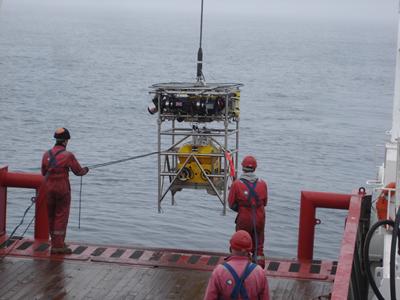Current research cruise: Understanding gas escape from the ocean floor
Southampton scientists are currently on board RRS James Clark Ross, taking part in an Arctic research cruise west of Svalbard, to investigate gas escape from the ocean floor.
Methane hydrate is formed from methane and water at high pressures and low temperatures, both of which are found at the bottom of the deep ocean. It is very widespread in the parts of the deep ocean nearest to the continents.
If the ocean warms, the hydrate can become unstable and methane gas can make its way into the ocean, forming plumes of bubbles.
In 2008 James Clark Ross cruise JR211 found numerous such plumes exactly where we would expect to see them. Evidence was found for the presence of gas and movement of fluids beneath the seabed, but not of exactly how the gas is getting out into the ocean.
The main aim of this current cruise JR269A, is to image the pathways taken by the gas and thereby to establish the link between the sub-surface fluid flow system and the surface gas seepage. The team will also collect further images of the bubble plumes to contribute to an international effort to monitor changes in these plumes over time, and test scientific equipment that will be used in 2012 to better determine how much gas and hydrate are present beneath the seabed in the region of the bubble plumes.
Equipment
The team will image the gas pathways using two different sound sources. Firstly they will use SYSIF, a “Chirp” sonar system developed by IFREMER, which is towed close to the seafloor and sends out a variable-pitch “hum” which allows features to be detected up to a few tens of metres below the seafloor in great detail. Secondly, a small “gun” will be used that creates an oscillating bubble of compressed air and sends out sounds of lower frequency that penetrate deeper beneath the seafloor. The sound of this gun will be detected by a 60-m cable of hydrophones (like microphones) towed just beneath the sea surface, which will allow features several hundred metres or more beneath the seafloor to be seen, but with less detail. Signals from both sound sources will be recorded on instruments placed on the ocean floor, and measurements of the time it takes for the sounds to reach these instruments will be used to work out the speed of sound beneath the seafloor and therefore the depths of the features that are seen.
A high-frequency echosounder system will be used to detect the bubble plumes and the team will measure salinity and temperature variations in the ocean to work out the effects of the ocean on our other observations. Finally, they will test an electromagnetic source towed close to the seabed and record signals from this source on seabed instruments.
Follow the research expedition at our cruise blog.
What's related

Related Staff Member
Scientific Party
National Oceanography Centre Southampton
Tim Minshull (Chief Scientist), Graham Westbrook, Martin Sinha, Angus Best, Simon Dean, Veit Huehnerbach, John Davis, Mark Vardy, Indika Samarakoon, Sudipta Sarkar, Hector Moreno, Neil Sloan, Andy Webb
IFREMER
Henri Martinossi, Bruno Marsset, Pierre Leon, Stephan Ker, Laurent Artzner, Jean-Pierre Regnault, Yannick Thomas, Jean Luc Le Philippe (Genavir)
University of Durham
Alan Burchell
University of Tromsoe
Anupama Rajan
The main aim of cruise JR269A is to image the pathways beneath the seabed taken by methane gas that we know is escaping from the ocean floor, so that we can work out how it is getting there. This gas escape may contribute to climate change and to ocean acidification.
